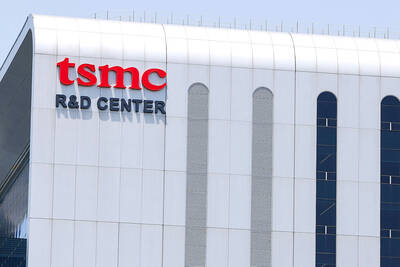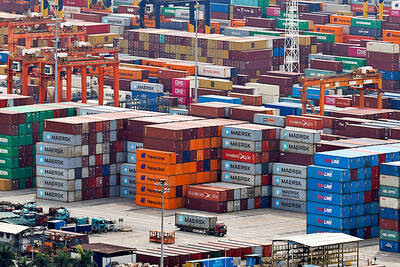AU Optronics Corp (AUO, 友達光電) yesterday said it planned to resume plans to build a sixth-generation (6G) factory in China that will produce high-end LCD flat panels used in smartphones and tablets, rather than large television panels as previously planned.
The nation’s No. 2 LCD panel maker has suspended the construction of an 8.5 generation (8.5G) plant, in China’s Kunshan City, Jiangsu Province, for about three years citing severe oversupply and weak global demand, which drove most panel companies into the red.
AUO originally planned to build the 8.5G plant to make TV panels via a joint venture with the Kunshan government. AUO got as far as completing the construction of the factory’s shell.
“The 6G plant will produce high-end flat panels for smartphones and tablets, using our low-temperature polycrystalline silicon [LTPS] technology,” company spokesperson Jessie Lee (李葦珠) said by telephone.
“We are seeing strong demand in China, which consumes 30 percent of smartphones made worldwide,” Lee said.
AUO said about 40 percent of smartphone panels made in its factories were shipped to China, making the country one of the company’s major revenue sources.
LTPS panels are expected to be used in more mobile devices from 2 percent penetration last year, as such panels can enhance their resolution to above 330ppi high-definition level and reduce power consumption, TrendForce Corp (集邦科技) said in a report released last month.
Amazon.com and Google have used LTPS panels in their high-definition Kindle Fire HD e-reader and Nexus 7 tablet respectively.
AUO’s announcement came amid a slew of LCD panel makers including Samsung Electronics, LG Display and Chinese makers such as BOE (京東方) planning to launch more 8.5G plants in China over the next few years. By 2015, there will be eight 8.5G plants in operation in China, according to NPD DisplaySearch’s forecast.
“For AUO, it should be a better choice to build a 6G plant in China because of less investment and bigger flexibility in making different sizes of panels,” TrendForce analyst Locke Chang (張小彪) said.
It will take NT$80 billion (US$2.65 billion) to US$100 billion to build an 8.5G production line, while it will only take half of the investment to build a 6G production line, Chang said.
The Hsinchu-based LCD panel maker did not release investment figures yesterday, with the amount invested and date of operation for the new Chinese plant depending on fundraising progress and the market situation, Lee said.
The company yesterday ordered new LCD panel manufacturing equipment worth NT$4.12 billion from equipment suppliers, including Applied Materials Inc and Hitachi Ltd, according to a company statement submitted to the Taiwan Stock Exchange. Shares of AUO rose 0.11 percent to NT$9.37 yesterday.

The Eurovision Song Contest has seen a surge in punter interest at the bookmakers, becoming a major betting event, experts said ahead of last night’s giant glamfest in Basel. “Eurovision has quietly become one of the biggest betting events of the year,” said Tomi Huttunen, senior manager of the Online Computer Finland (OCS) betting and casino platform. Betting sites have long been used to gauge which way voters might be leaning ahead of the world’s biggest televised live music event. However, bookmakers highlight a huge increase in engagement in recent years — and this year in particular. “We’ve already passed 2023’s total activity and

Nvidia Corp CEO Jensen Huang (黃仁勳) today announced that his company has selected "Beitou Shilin" in Taipei for its new Taiwan office, called Nvidia Constellation, putting an end to months of speculation. Industry sources have said that the tech giant has been eyeing the Beitou Shilin Science Park as the site of its new overseas headquarters, and speculated that the new headquarters would be built on two plots of land designated as "T17" and "T18," which span 3.89 hectares in the park. "I think it's time for us to reveal one of the largest products we've ever built," Huang said near the

BIG BUCKS: Chairman Wei is expected to receive NT$34.12 million on a proposed NT$5 cash dividend plan, while the National Development Fund would get NT$8.27 billion Taiwan Semiconductor Manufacturing Co (TSMC, 台積電), the world’s largest contract chipmaker, yesterday announced that its board of directors approved US$15.25 billion in capital appropriations for long-term expansion to meet growing demand. The funds are to be used for installing advanced technology and packaging capacity, expanding mature and specialty technology, and constructing fabs with facility systems, TSMC said in a statement. The board also approved a proposal to distribute a NT$5 cash dividend per share, based on first-quarter earnings per share of NT$13.94, it said. That surpasses the NT$4.50 dividend for the fourth quarter of last year. TSMC has said that while it is eager

China yesterday announced anti-dumping duties as high as 74.9 percent on imports of polyoxymethylene (POM) copolymers, a type of engineering plastic, from Taiwan, the US, the EU and Japan. The Chinese Ministry of Commerce’s findings conclude a probe launched in May last year, shortly after the US sharply increased tariffs on Chinese electric vehicles, computer chips and other imports. POM copolymers can partially replace metals such as copper and zinc, and have various applications, including in auto parts, electronics and medical equipment, the Chinese ministry has said. In January, it said initial investigations had determined that dumping was taking place, and implemented preliminary